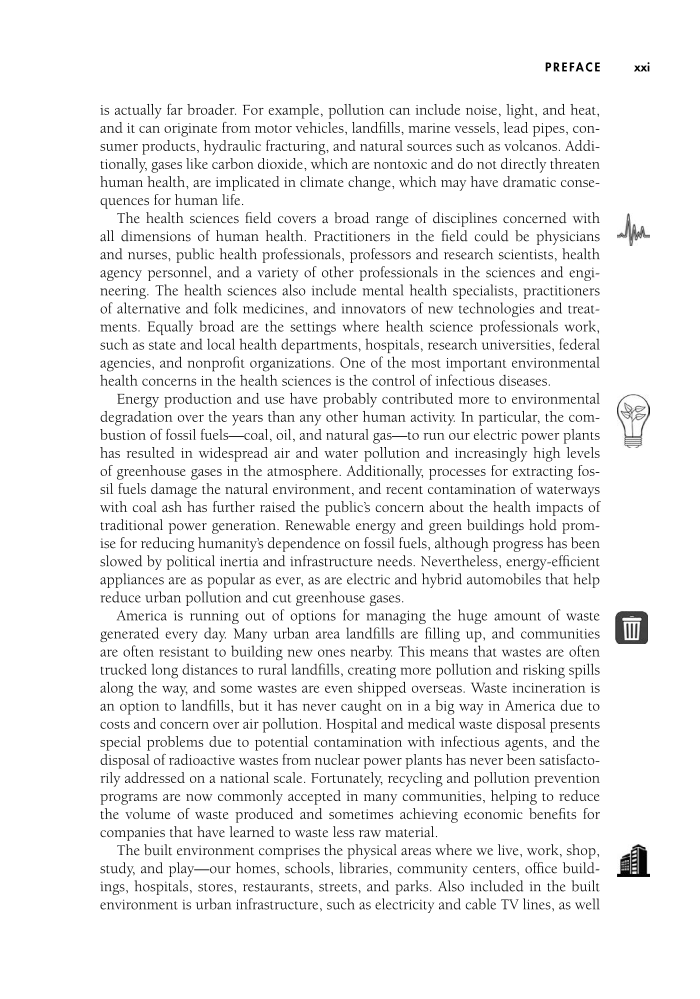PREFACE xxi is actually far broader. For example, pollution can include noise, light, and heat, and it can originate from motor vehicles, landfi lls, marine vessels, lead pipes, con- sumer products, hydraulic fracturing, and natural sources such as volcanos. Addi- tionally, gases like carbon dioxide, which are nontoxic and do not directly threaten human health, are implicated in climate change, which may have dramatic conse- quences for human life. The health sciences fi eld covers a broad range of disciplines concerned with all dimensions of human health. Practitioners in the fi eld could be physicians and nurses, public health professionals, professors and research scientists, health agency personnel, and a variety of other professionals in the sciences and engi- neering. The health sciences also include mental health specialists, practitioners of alternative and folk medicines, and innovators of new technologies and treat- ments. Equally broad are the settings where health science professionals work, such as state and local health departments, hospitals, research universities, federal agencies, and nonprofi t organizations. One of the most important environmental health concerns in the health sciences is the control of infectious diseases. Energy production and use have probably contributed more to environmental degradation over the years than any other human activity. In particular, the com- bustion of fossil fuels—coal, oil, and natural gas—to run our electric power plants has resulted in widespread air and water pollution and increasingly high levels of greenhouse gases in the atmosphere. Additionally, processes for extracting fos- sil fuels damage the natural environment, and recent contamination of waterways with coal ash has further raised the public’s concern about the health impacts of traditional power generation. Renewable energy and green buildings hold prom- ise for reducing humanity’s dependence on fossil fuels, although progress has been slowed by political inertia and infrastructure needs. Nevertheless, energy-effi cient appliances are as popular as ever, as are electric and hybrid automobiles that help reduce urban pollution and cut greenhouse gases. America is running out of options for managing the huge amount of waste generated every day. Many urban area landfi lls are fi lling up, and communities are often resistant to building new ones nearby. This means that wastes are often trucked long distances to rural landfi lls, creating more pollution and risking spills along the way, and some wastes are even shipped overseas. Waste incineration is an option to landfi lls, but it has never caught on in a big way in America due to costs and concern over air pollution. Hospital and medical waste disposal presents special problems due to potential contamination with infectious agents, and the disposal of radioactive wastes from nuclear power plants has never been satisfacto- rily addressed on a national scale. Fortunately, recycling and pollution prevention programs are now commonly accepted in many communities, helping to reduce the volume of waste produced and sometimes achieving economic benefi ts for companies that have learned to waste less raw material. The built environment comprises the physical areas where we live, work, shop, study, and play—our homes, schools, libraries, community centers, offi ce build- ings, hospitals, stores, restaurants, streets, and parks. Also included in the built environment is urban infrastructure, such as electricity and cable TV lines, as well
Document Details My Account Print multiple pages
Print
You have printed 0 times in the last 24 hours.
Your print count will reset on at .
You may print 0 more time(s) before then.
You may print a maximum of 0 pages at a time.





















































































































































































































































































































































































































































































































































































































































































































































































